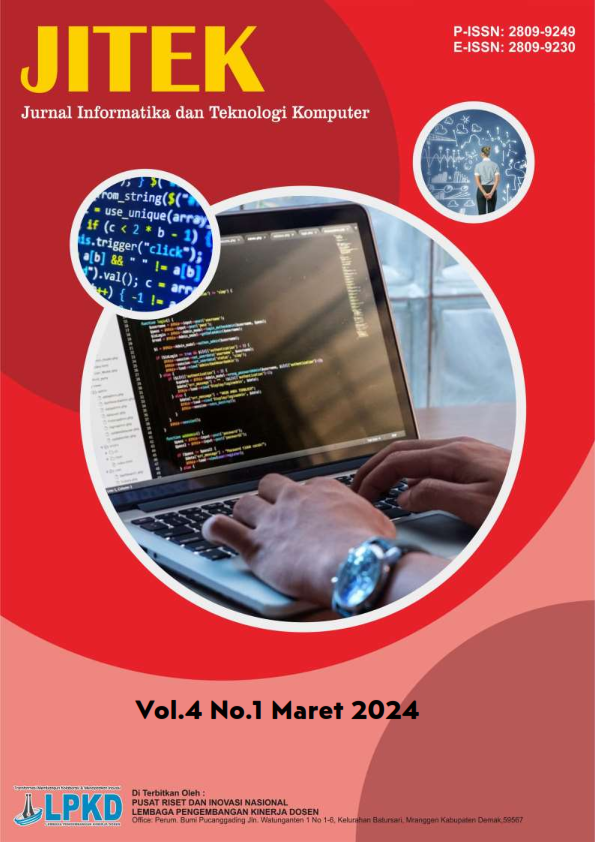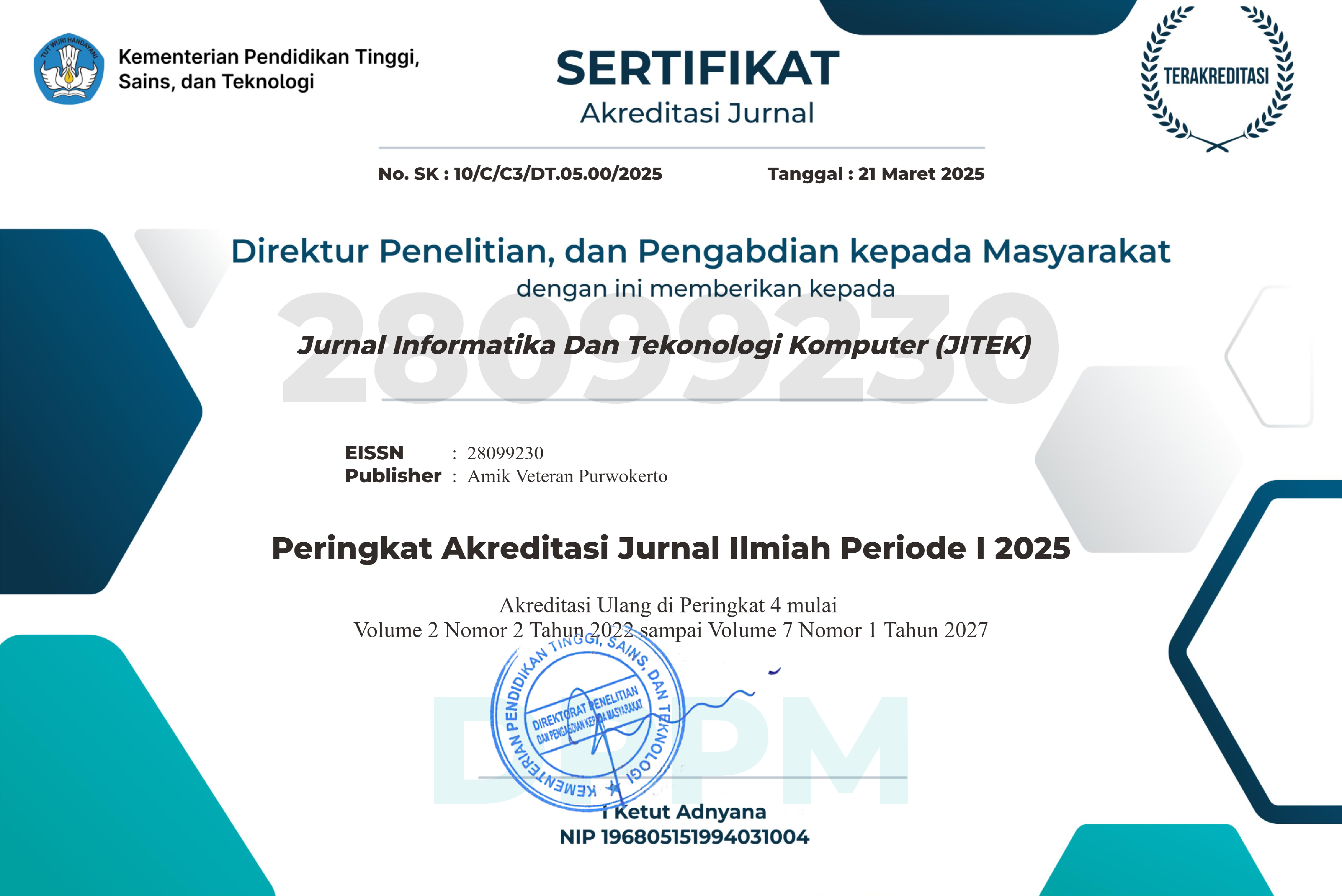Quantum Key Distribution (QKD) as a Wireless Telecommunications Security Solution
DOI:
https://doi.org/10.55606/jitek.v5i1.5765Keywords:
quantum cryptography, quantum key distribution, security solution, wireless telecommunicationAbstract
The purpose of this research is to analyze and explore quantum theorems as a wireless telecommunications security solution in the future. This study uses a quantitative approach through simulation and performance analysis of QKD systems in wireless channels, by combining literature studies and comparative analysis between QKD and PQC. Meanwhile, the wireless communication simulation model, using the QKD protocol and PQC algorithm, with Free Space Optics (FSO), WiFi, and LiFi-based network scenarios. The simulation was carried out using MATLAB. This study is based on QKD, which uses BB84 and CV-QKD protocols on FSO 100m and LiFi wireless channels. And based on PQC, which uses the Kyber algorithm, with AES authentication for communication. Both models were simulated and tested based on the parameters of Quantum Bit Error Rate, Key Generation Rate, latency, and resistance to third-party attacks (wiretapping detection). Furthermore, the analysis was carried out quantitatively and comparatively to compare the performance of QKD and PQC based on the QBER, latency, KGR, and wiretapping detection of implementation. This analysis are combined with data based on the literature, to formulate optimal implementation strategies in the context of future wireless networks. The results indicate that QKD, specifically CV-QKD, has significant potential for use in attack-sensitive wireless communications, such as military, government, and industrial applications. However, this model requires more complex hardware and infrastructure investments in its implementation. Meanwhile, PQC offers a more ready-to-use and cost-effective solution for everyday communications that remains resilient to quantum attacks.
References
Ahilan, A., & Jeyam, A. (2023). Breaking barriers in conventional cryptography by integrating with quantum key distribution. Wireless Personal Communications, 129, 549–567. https://doi.org/10.1007/s11277-022-10110-8
Alghamdi, M. I. (2025). A review on quantum key distribution for wireless networks: Current status and future prospects. Communications on Applied Nonlinear Analysis, 32(2s). https://doi.org/10.52783/cana.v32.2516
Alshaer, N., Moawad, A., & Ismail, T. (2021). Reliability and security analysis of an entanglement-based QKD protocol in a dynamic ground-to-UAV FSO communications system. IEEE Access, 1–1. https://doi.org/10.1109/ACCESS.2021.3137357
Aquina, N., Cimoli, B., Das, S., Hövelmanns, K., Weber, F. J., Okonkwo, C., ... & Verschoor, S. (2025). A critical analysis of deployed use cases for quantum key distribution and comparison with post-quantum cryptography. Cryptology ePrint Archive.
Arute, F., Arya, K., Babbush, R., Bacon, D., Bardin, J. C., Barends, R., ... & Martinis, J. M. (2019). Quantum supremacy using a programmable superconducting processor. Nature, 574(7779), 505–510. https://doi.org/10.1038/s41586-019-1666-5
Basset, F. B., Valeri, M., Roccia, E., Poderini, D., Neuwirth, J., Spagnolo, N., ... & Trotta, R. (2021). Quantum key distribution with entangled photons generated on demand by a quantum dot. Science Advances, 7(12). https://doi.org/10.1126/sciadv.abe6379
Bennett, C. H., & Brassard, G. (2014). Quantum cryptography: Public key distribution and coin tossing. Theoretical Computer Science, 560, 7–11. https://doi.org/10.1016/j.tcs.2014.05.025
Biswas, S., Goswami, R. S., Reddy, K. H. K., Mohanty, S. N., & Ahmed, M. A. (2024). Advancing quantum communication security: Metamaterial-based quantum key distribution with enhanced protocols. IET Quantum Communication, 5(4), 399–416. https://doi.org/10.1049/qtc2.12116
Carrasco-Casado, A., Fernández, V., & Denisenko, N. (2016). Free-space quantum key distribution. In M. Uysal, C. Capsoni, Z. Ghassemlooy, A. Boucouvalas, & E. Udvary (Eds.), Optical wireless communications (pp. 499–523). Springer. https://doi.org/10.1007/978-3-319-30201-0_27
Chunduru, A., Lenka, S., Neelima, N., & Easwaramoorthy, S. (2024). A secure method of communication through BB84 protocol in quantum key distribution. Scalable Computing: Practice and Experience, 25, 21–33. https://doi.org/10.12694/scpe.v25i1.2152
Haiyu Yang, G. L., Zhang, J., Liu, H., & Hu, A. (2021). Fast and secure key generation with channel obfuscation in slowly varying environments. https://doi.org/10.48550/arXiv.2112.02273
Huang, P., Huang, J., Zhang, Z., & Zeng, G. (2018). Quantum key distribution using basis encoding of Gaussian-modulated coherent states. Physical Review A, 97(4). https://doi.org/10.1103/PhysRevA.97.042311
Jiao, L., Wang, N., Wang, P., Fanid, A. A., Tang, J., & Zeng, K. (2019). Physical layer key generation in 5G wireless networks. Electrical Engineering and Systems Science. https://doi.org/10.48550/arXiv.1908.10362
Kundu, N. K., McKay, M. R., & Mallik, R. K. (2024). Wireless quantum key distribution at terahertz frequencies: Opportunities and challenges. IET Quantum Communication, 5(4), 450–461. https://doi.org/10.1049/qtc2.12085
Lim, C. C., Xu, F., Pan, J. W., & Ekert, A. (2021). Security analysis of quantum key distribution with small block length and its application to quantum space communications. Physical Review Letters, 126(10). https://doi.org/10.1103/PhysRevLett.126.100501
Maiwada, U. D., Danyaro, K. U., Sarlan, A., Liew, M. S., Taiwo, A., & Audi, U. I. (2024). Energy efficiency in 5G systems: A systematic literature review. International Journal of Knowledge-Based and Intelligent Engineering Systems, 28(1), 93–132. https://doi.org/10.3233/KES-230061
Matsuura, T., Maeda, K., Sasaki, T., & Koashi, M. (2021). Finite-size security of continuous-variable quantum key distribution with digital signal processing. Nature Communications, 12, 1–11. https://doi.org/10.1038/s41467-020-19916-1
Mavroeidis, V., Vishi, K., Zych, M., & Jøsang, A. (2018). The impact of quantum computing on present cryptography. International Journal of Advanced Computer Science and Applications, 9(3). https://doi.org/10.14569/IJACSA.2018.090354
Pereira, M., Lorenzo, G. C., Navarrete, A., Mizutani, A., Kato, G., Curty, M., & Tamaki, K. (2023). Modified BB84 quantum key distribution protocol robust to source imperfections. Physical Review Research, 5. https://doi.org/10.1103/PhysRevResearch.5.023065
Pirandola, S. (2021). Composable security for continuous-variable quantum key distribution: Trust levels and practical key rates in wired and wireless networks. Physical Review Research, 3(4). https://doi.org/10.1103/PhysRevResearch.3.043014
Pirandola, S., Andersen, U. L., Banchi, L., Berta, M., Bunandar, D., Colbeck, R., ... & Wallden, P. (2020). Advances in quantum cryptography. Advances in Optics and Photonics, 12(4), 1012–1236.
Primaatmaja, I. W., Goh, K. T., Tan, E. Y. Z., Khoo, J. T. F., Ghorai, S., & Lim, C. C. W. (2023). Security of device-independent quantum key distribution protocols: A review. Quantum, 7, 932. https://doi.org/10.22331/q-2023-03-02-932
Sahu, S. K., & Mazumdar, K. (2024). State-of-the-art analysis of quantum cryptography: Applications and future prospects. Frontiers in Physics, 12. https://doi.org/10.3389/fphy.2024.1456491
Shor, P. W. (1994). Algorithms for quantum computation: Discrete logarithms and factoring. In Proceedings of the 35th Annual Symposium on Foundations of Computer Science (pp. 124–134). IEEE. https://doi.org/10.1109/SFCS.1994.365700
Stanley, M., Gui, Y., Unnikrishnan, D., Hall, S. R. G., & Fatadin, I. (2022). Recent progress in quantum key distribution network deployments and standards. Journal of Physics: Conference Series, 2416(1). https://doi.org/10.1088/1742-6596/2416/1/012001
Su, H. Y. (2020). Simple analysis of security of the BB84 quantum key distribution protocol. Quantum Information Processing, 19, 169. https://doi.org/10.1007/s11128-020-02663-z
Sun, S., & Huang, A. (2022). A review of security evaluation of practical quantum key distribution system. Entropy, 24(2), 260. https://doi.org/10.3390/e24020260
Tan, X. (2013). Introduction to quantum cryptography. In Theory and Practice of Cryptography and Network Security Protocols and Technologies.
Wang, W., & Lütkenhaus, N. (2022). Numerical security proof for the decoy-state BB84 protocol and measurement-device-independent quantum key distribution resistant against large basis misalignment. Physical Review Research, 4. https://doi.org/10.1103/PhysRevResearch.4.043097
Wen, X., Li, Q., Mao, H., Wen, X., & Chen, N. (2021). Rotation-based slice error correction protocol for continuous-variable quantum key distribution and its implementation with polar codes. https://doi.org/10.48550/arXiv.2106.06206
Xu, F., Ma, X., Zhang, Q., Lo, H. K., & Pan, J. W. (2020). Secure quantum key distribution with realistic devices. Reviews of Modern Physics, 92(2), 025002. https://doi.org/10.1103/RevModPhys.92.025002
Downloads
Published
How to Cite
Issue
Section
License
Copyright (c) 2025 Jurnal Informatika Dan Tekonologi Komputer (JITEK)

This work is licensed under a Creative Commons Attribution-ShareAlike 4.0 International License.








